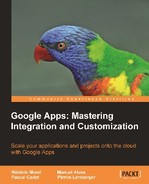The upcoming Cloud Computing tools and new products such as the Google Apps are going to shape and accelerate the evolution of enterprise IS. To illustrate this evolution, let's examine the present situation for most IS.
Information systems are structured around three distinct layers:
- The first layer is the infrastructure, the foundation underlying the IS that is used by all components. This foundation includes at least the networking equipment, the servers, and shared elements such as directories, proxies, or firewalls.
- The second includes applications (ERP, e-commerce, supply-chain, CRM, groupware, portals…). These are most often organized into autonomous silos and communicate little with each other.
- The third includes the user desktop. This has changed very little over the past 20 years and is still based on a classical PS running Windows.
The following figure illustrates a typical IS with its PC desktops, business applications, and the foundations:

Cloud Computing actors imagine a new landscape in computing and information systems that should be more flexible and at the same time more agile. Google's vision is based on generalizing web technologies to business applications, to the usual office productivity tools (spreadsheets, word processing), fueled by a massive adoption of mobile technologies. Once most applications are web apps, it becomes legitimate to question the Windows-based PC desktop that we have been accustomed to for over 20 years now. This old paradigm is indeed challenged by an emerging model: a lightweight desktop built around a single applica tion, namely: the browser. The economic stakes here are enormous because the desktop is a major expenditure for many IT departments.
The following figure illustrates Google's vision for the 2010s IS. Some application silos are simply outsourced in the cloud, especially for commodities such as email, calendaring, collaborative portals, and office tools. For the time being, the more specialized business applications still remain in-house. The classical desktop such as PC/Windows or Mac OS is clearly declining, and is limited to launching older client-server applications or standalone applications. The decline of the PC is for the benefit of a lighter weight desktop on one hand and of course for the newer generation of smart phones and mobile terminals (Google's Android and of course Apple's iPhone and iPad). Chapter 10 is devoted to the Google desktop and will discuss these issues in more depth.
What characterizes this type of IS, is the use of open standards, guaranteeing interoperability at all levels:
- Sharing identities and authorizations: Each application can work with identities that come from an external repository.
- Integration within enterprise portal solution: To unify application access.
- Integration with processes and data using indexation mechanisms and two-way exchanges that go beyond those offered by classical silos.

Finally, in Google's vision, the Google Apps suite is much more than a simple office suite: rather, it is meant to provide the basic building blocks for the IS of the future. For this reason, the platform offers many options to integrate the Google Apps services with other existing components. The Google Apps Marketplace, just like the Apple Store, provides easy access to solutions from partners that offer products and services that supplement the basic offer.
